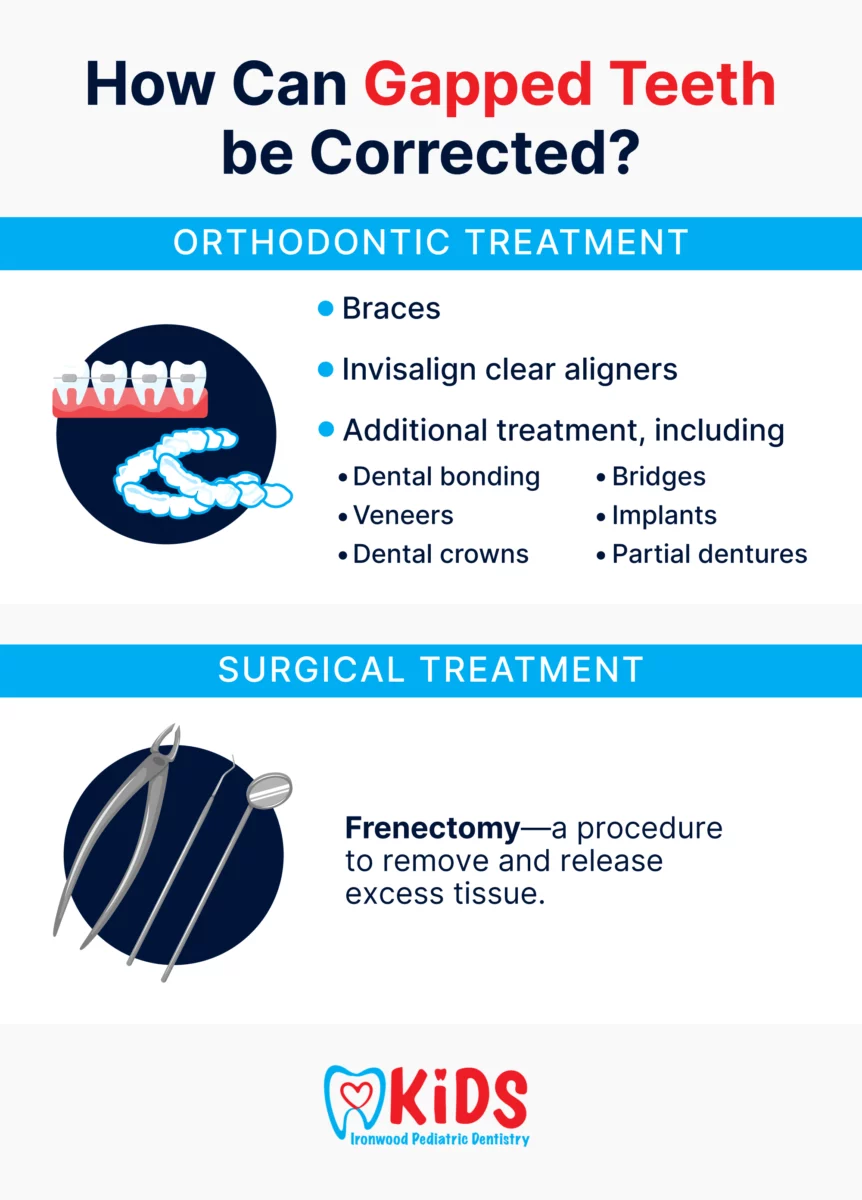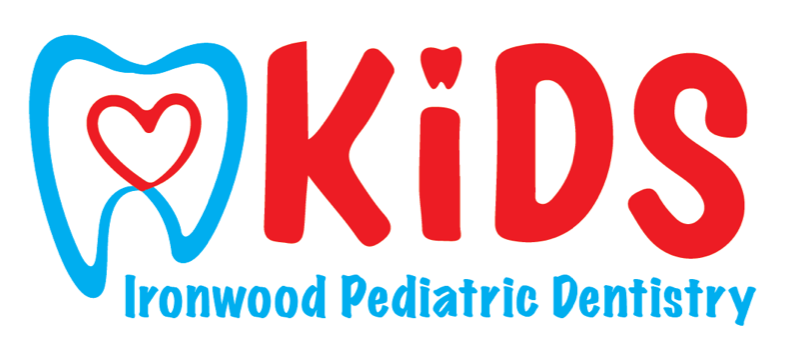Having gaps between teeth is a common occurrence in children. Medically speaking, a “gapped smile” is the result of a condition called diastema. In this post we consider what causes gapped front teeth, and what you can do about it if it happens with your child.
If you would like to explore orthodontic treatment for gaps in your child’s teeth, please call Ironwood Pediatric Dentistry at (480) 422-4544 or use our contact form.
What Causes Gapped Teeth in Children?
Diastema frequently occurs in the form of gapped front teeth, in particular the upper front teeth. But it can happen between any two teeth in the mouth.
Common causes of diastema include:
- A mismatch between undersized teeth and the jawbone.
- Having an oversized labial frenum, a condition also known as “lip tie.” This describes the tissue that connects the upper lip to the gums.
- Tongue thrusting. This describes a behavior that occurs during swallowing, when instead of moving the tongue to the roof of the mouth a child presses the tip of the tongue against the upper front teeth.
- Digit sucking. Most commonly known as thumb-sucking, but it can happen when any fingers are placed in the mouth for long periods.
- Prolonged pacifier use. Similar in its effect to digit-sucking.
- Missing teeth. When a tooth is missing, the surrounding teeth can shift position into the resulting space, creating gaps between teeth.
Are Gapped Teeth Bad for Children?
The good news is that having gaps between teeth is not ordinarily a serious dental condition. In many cases, having some extra “wiggle room” between teeth is a good thing because it allows the permanent tooth room to erupt normally into their optimal positions.
It is usually a better thing to have a little too much space between baby teeth than to have overcrowded teeth, which can create trouble with the proper eruption of the permanent ones.
Many times, parents will want to help their children correct tooth gaps mainly as a way to help those children overcome feelings of awkwardness and being self-conscious because of gapped smile flaws.
When Can Gapped Teeth Be a Problem for Children?
Two situations can arise in which gapped teeth can pose challenges for children more significantly than a smile affected by gapped front teeth.
These are:
- Premature loss of baby teeth. If some baby teeth fall out too soon before the permanent teeth erupt, this can cause the remaining baby teeth to shift position in an unnatural way, which can interfere with the eruption of the permanent teeth into their proper positions.
- Missing permanent teeth. Sometimes, children will not develop all 32 permanent teeth. In these cases, a gap can remain in spaces where a permanent tooth would normally erupt but does not.
- Speech Impediments and chewing problems. The more tooth gaps that exist, and with bigger gaps, the more the possibility increases that they could interfere with your child’s ability to pronounce certain sounds or words or to chew food thoroughly.
What Are the Symptoms of Diastema?
In many cases, gapped teeth cause no symptoms.
However, if periodontal disease (advanced gum disease) or tongue thrusting are contributing to gapped teeth, then over time, the gaps may continue to increase and dental pain can result when biting or chewing or teeth loosen.
Can Diastema Correct Itself Naturally?
Often, as your child grows, small gaps between the baby teeth will close up on their own once all the permanent teeth erupt. But if the space is too great or other problems persist, then help from your pediatric dentist or orthodontist may be needed.
Is There Any Way to Prevent Diastema?
In many cases, such as whether your child has an oversized labial frenum or will develop all 32 permanent teeth, you can do little or nothing to influence how these contribute to gapped teeth.
What you can do to decrease the risk of gapped teeth is to encourage your child to develop good oral health habits. Specifically, you can do the following:
- Practice good oral hygiene. Regular brushing and flossing can help prevent tooth decay and gum disease. Healthy teeth are much more likely to resist tooth decay and loosening, and are thus less likely to move out of place to cause tooth gaps.
- Practice good oral health habits. If your child engages in digit sucking or tongue thrusting behaviors, your pediatric dentist can help you to find ways to encourage them to stop these activities, and thus to reduce the risk they pose to the onset of diastema.
- Take your children to your pediatric dentist for regular check-ups. A child dentist is professionally trained to recognize developing problems that can lead to, or worsen, gapped teeth. Early detection of diastema can be effective in prompt and effective treatment.
How Can A Dentist or Orthodontist Correct Gapped Teeth?
When gapped teeth cannot correct on their own, treatment options are available. The most common ones are orthodontics, and in some cases a procedure called a frenectomy.

Orthodontic Treatment for Gapped Teeth
Orthodontic appliances like braces or custom-made Invisalign treatment are effective in correcting misaligned teeth and bringing teeth closer together.
Orthodontics can be used together with or separately from other treatments, such as dental bonding, veneers, crowns, bridges, implants, or partial dentures.
Another way to resolve gaps from diastema is to use cosmetic dentistry options, such as porcelain veneers, tooth-colored resins, crowns, or bonding. For missing teeth, a dental bridge, partial denture, or dental implant may be needed.
Braces are effective in treating most gapped teeth conditions. Invisalign clear aligners are effective in many situations, but in significant tooth gap cases, they may not be as effective as braces.
Frenectomy Treatment
A frenectomy is a procedure to remove and release excess tissue. In a case involving an oversized labial frenum, this will allow related tooth gaps to close normally.
Does Your Child Have Gapped Teeth?
If your child has a tooth cap, call Ironwood Pediatric Dentistry at (480) 422-4544. We specialize in kids’ dentistry and orthodontics. If you think your child may need orthodontic work to correct a teeth gap problem, we offer free consultations to help you understand your options.
You can also use our online contact form to ask questions or set up an appointment.
